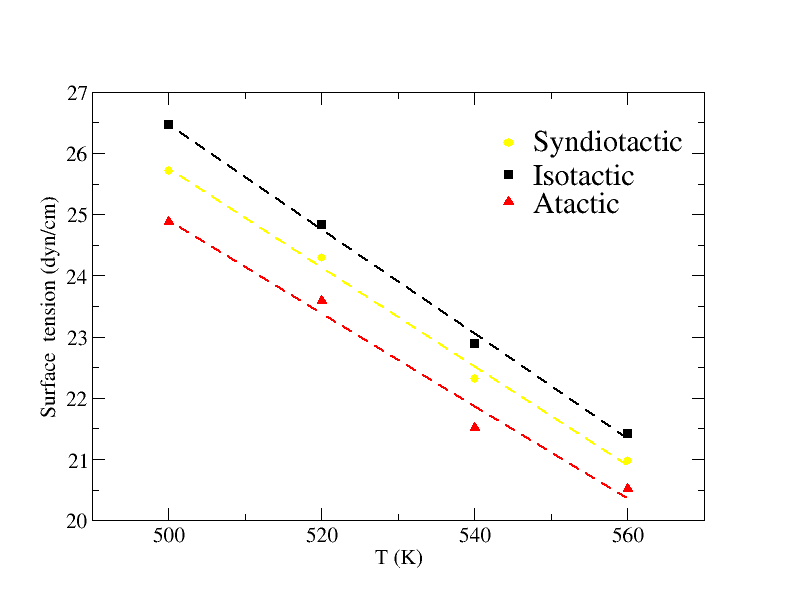Reports: ND554801-ND5: Surfactant Induced Ordering at the Oil-Water Interface: Thermodynamic, Kinetic, and Viscoelastic Considerations
Mesfin Tsige, The University of Akron
PRF Grant Report
During the first year of this project we have shown using all-atom molecular dynamics simulation that the structure (ordering) and dynamics of polymers, such as poly(methylmethacrylate) (PMMA) near surfaces and interfaces, may require over hundreds of nanoseconds of equilibration to determine their surface properties. We have implemented several important improvements in order to simulate PMMA films using molecular dynamics simulations. As a result, we were able to provide a key insight into how chain conformations control the migration of chemical groups to a surface and how this leads to subtle change in surface tension. In figure 1 below, surface tension as a function of temperature for three tacticities of PMMA is presented. This surface tension result proves that the simulation provides quantification that could be very challenging, if not impossible, to obtain through surface sensitive spectroscopy and contact angle measurements.
Figure 1. Surface tension versus temperature for iso-(squares), syn-(circles), and atac-(triangles)
PMMA after tail corrections.
The surface tension of isotactic PMMA is higher than syndiotactic PMMA and the latter one is higher than atactic PMMA. Experimental results on the surface properties of stereoregular PMMA have been inconclusive, but hypothesized isotactic PMMA to be the most hydrophilic of the three tacticities in agreement with our prediction from simulation1-4. We have connected the observed surface tension differences between the three tacticities to their surface composition and chain conformation at the surface. Figure 2 shows the computed ratios of chemical groups (specifically a-methyl, ester-methyl, and carbonyl groups) for isotactic/syndiotactic and isotactic/atactic PMMA at 560 K as a function of distance from the surface of the films.
Figure 2. Chemical group ratios for A) iso-/syn- and B) iso-/atac- PMMA at 560 K in vacuum as
function of distance from the top surface as measured through the local maxima.
These relative ratios shown in Figure 2 provide an explanation for differences in observed surface tension values reported in Figure 1. The a-methyl groups are relatively depleted and ester-methyl and carbonyl groups are in relative excess at the surface for isotactic PMMA in comparison to syndiotactic PMMA. This makes the isotactic PMMA surface relatively more hydrophilic, which is consistent with the higher surface tension of isotactic PMMA.
As clearly demonstrated above, all-atom molecular dynamics offers significant advantages in capturing small differentials with tacticity. We will extend the investigation in changes in the ratio of the different functional groups at the surface when the three tacticities are in contact with water and oil. This investigation will be connected with alkane/surfactant-water interface which is the main objective of the proposed work.
References
1. Blokhuis, E.; Bedeaux, D.; Holcomb, C.; Zollweg, J. Mol. Phys. 1995, 85, 665_669.
2. Tretinnikov, O. N.; Ohta, K. Langmuir 1998, 14, 915_920.
3. Tretinnikov, O. N. J. Adhes. Sci. Technol. 1999, 13, 1085_1102.
4. Fujii, Y.; Akabori, K.-i.; Tanaka, K.; Nagamura, T. Polym. J. 2007, 39, 928_934.













